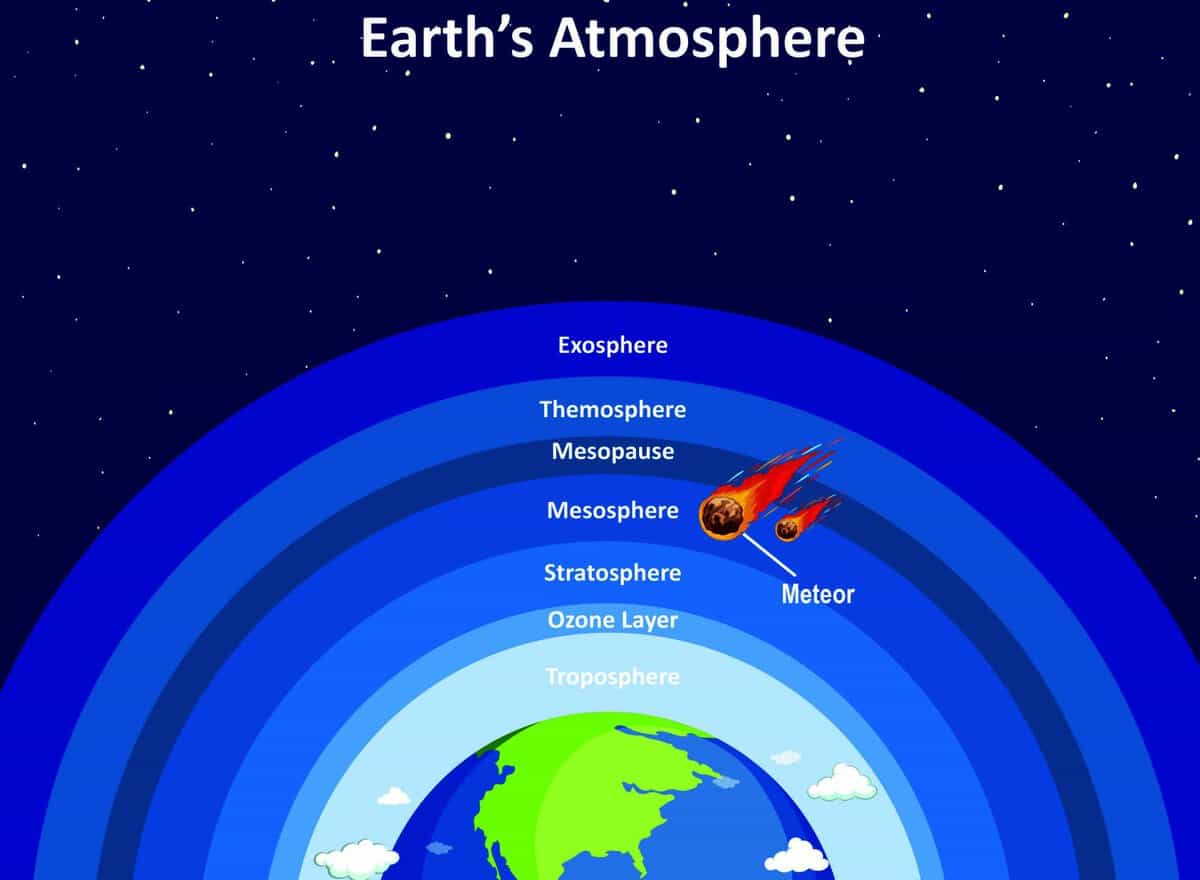
The atmosphere, often referred to as the air envelope surrounding Earth, is sustained by the force of gravity and rotates along with the planet. The presence of air is vital for the existence of life on Earth, as all living organisms rely on the oxygen found in the atmosphere for respiration. Without this essential element, sustaining life on our planet would be impossible. Moreover, the atmosphere serves as a protective shield, preventing drastic temperature fluctuations that could potentially lead to overheating or cooling. Additionally, it plays a role in the incineration of meteorites that enter Earth’s atmosphere. Furthermore, the oxygen present in the atmosphere is crucial for supporting combustion and oxidation processes, enabling human engagement in various economic activities.

Composition of Earth’s Atmosphere
The Earth’s atmosphere is composed of a variety of gases. These gases include nitrogen, oxygen, carbon dioxide, inert gases, and other elements. The table below shows the percentage of each gas in the atmosphere.
| Nitrogen | 78% |
| Oxygen | 21% |
| Carbon Dioxide | 0.04% |
| Inert Gases | 0.93% |
| Other Constituents | 0.03% |
In addition to these gases, the atmosphere also contains water vapor, dust, and other gases. The composition of these impurities can vary depending on the location and other factors. For example, sea air contains particles of salt and other beneficial substances for humans, making it considered therapeutic.
Composition of the atmosphere
The atmosphere is not clearly defined and extends into the Earth’s crust. However, the lower boundary is commonly considered to be the Earth’s surface. The upper boundary of the atmosphere is approximately 1000 km above the surface, beyond which lies outer space.
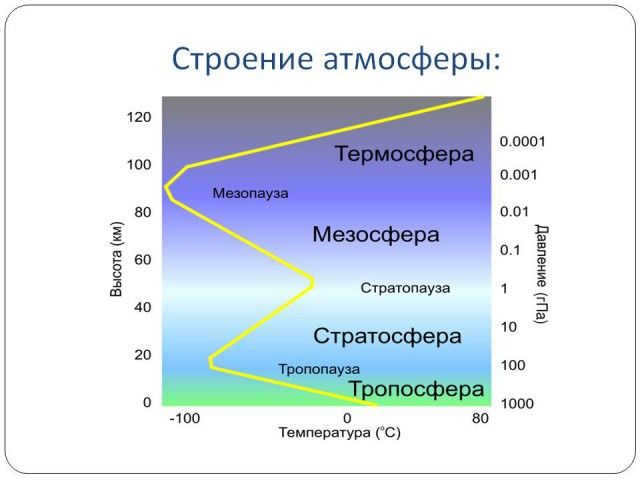
The atmosphere is made up of different layers. If we arrange them in order from the Earth, they would look like this:
The troposphere contains the majority of the water vapor and 80% of the oxygen. The thickness of this layer varies at different latitudes. In the equator, it extends 18 km from the Earth’s surface, while at the poles it extends 10 km.
Despite active use, the oxygen content in the atmosphere remains constant. Plants are the main suppliers of oxygen as they produce it through photosynthesis.
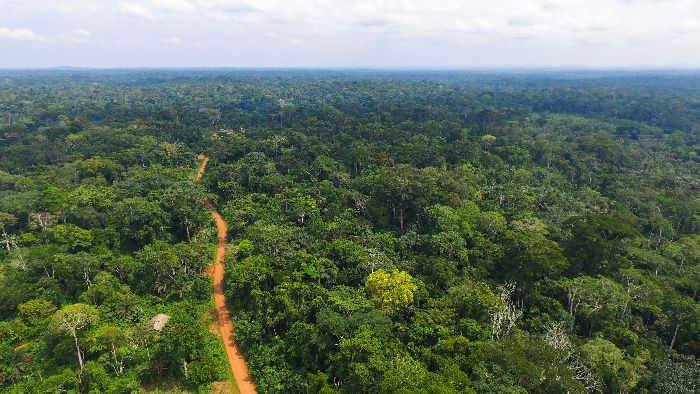
The troposphere, which is the most dense layer, is responsible for the formation of weather.
Above the troposphere lies the stratosphere, which extends to a height of 50-55 km. Unlike the troposphere, the stratosphere lacks water vapor and has very little oxygen, resulting in rarefied air that is unsuitable for breathing.
Within the lower part of the stratosphere exists the ozone layer, composed of ozone. This layer plays a crucial role in protecting the planet by capturing ultraviolet rays. While small amounts of these rays are beneficial, excessive exposure can be detrimental to all living organisms.
Unfortunately, the ozone layer has been shrinking due to modern industrial development, resulting in the emergence of ozone holes. In response, humanity is taking measures to prevent further destruction of this vital layer.

Above the stratosphere, there are the upper layers of the atmosphere. These layers contain only traces of air, with very little actual air present. This region gradually transitions into outer space.
What have we discovered?
The atmosphere is a crucial protective layer surrounding the planet. It consists of three distinct layers: the troposphere, the stratosphere, and the upper atmosphere. The envelope is primarily composed of air, with nitrogen being the main component. Oxygen is the most significant gas, as it is essential for the development of life on Earth.

In the 20th century, there was a significant increase in discussions about the atmosphere. This was not only due to the expansion and deepening of our knowledge, but also because pollution gradually became the central issue of concern.

As we enter the 21st century, humanity is facing increasingly serious challenges and even the potential threat of the extinction of life on Earth. However, it is important to understand why the atmosphere is so crucial for human existence, the role it plays in the planet’s survival, and what exactly it is.
The gas envelope that encircles celestial objects is known as the atmosphere. This characteristic is not exclusive to Earth, as all planets within our solar system possess a layer of gas. However, Mercury is the only planet that does not have an atmosphere. The gas giants, on the other hand, have an exceptionally dense atmospheric layer that is held in place by the force of gravity.
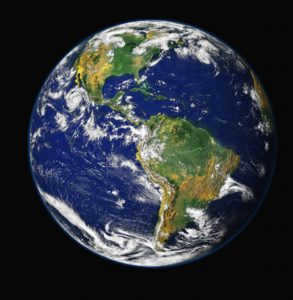
It is impossible to visually determine the exact boundary between the atmosphere and interplanetary space in this location.
Therefore, the term “atmosphere” refers to the region surrounding a planet (or other celestial body) in which gases rotate along with the celestial body.
In essence, a strong and unified connection is formed.
Since this article focuses on the Earth’s atmosphere, let’s take a detailed look at its structure. The gas envelope is not uniform, and scientists have identified distinct layers. Each layer has its own role and composition.
Composition
The exosphere is the outermost layer, bordering directly on interplanetary space, and can be reached at an altitude of approximately 1,000 kilometers. In this layer, individual particles move at high speeds and the gravitational force is reduced, allowing them to escape the boundaries of the atmosphere and venture into space.
Below the exosphere is the ionosphere, which is considered the uppermost layer and begins at 80 kilometers. This region is inhabited by charged particles and experiences significant magnetic fluctuations. The mesmerizing phenomenon of the northern lights, which can be observed from certain regions on Earth’s surface, also adds vibrant colors to the ionosphere.
Following the ionosphere is the mesosphere, a sparsely populated layer situated at the 80-kilometer mark.
The troposphere is the layer that all humans come into contact with. It has a height ranging from 8 to 16 kilometers. This layer is responsible for providing the air that we breathe, where precipitation is formed, and where all water vapor is concentrated. The air in the troposphere has the ability to move in both vertical and horizontal directions.
Based on the information above, it is evident that the thickness of the atmospheric layers is not uniform across different parts of the planet. Additionally, it varies depending on various conditions.
The atmosphere plays a crucial role in the origin, development, and preservation of life on Earth. Without it, the miracle of life on this planet would never have occurred. So, what makes the atmosphere so unique? Why is it essential and deserving of careful treatment?
Humans depend on air for respiration
Multicellular organisms cannot survive without oxygen. The Earth’s atmosphere consists of various layers, and the troposphere contains approximately 20% of this essential gas. Nitrogen makes up about 80% of the atmosphere, while smaller amounts of argon, carbon dioxide, ozone, and inert gases are present.
It is believed that life on Earth originated with nitrogen-absorbing bacteria. Over time, microorganisms and plants evolved, actively releasing oxygen as a by-product. The diverse life forms we see today emerged once the concentration of oxygen reached just one percent.
Although the proportion of carbon dioxide in the atmosphere may seem insignificant, it is steadily increasing due to human activities.
It must be understood that if the gas concentration increases by just 0.1 percent, it will have a detrimental effect on the ability of animals to breathe and pose a threat to human health.
The ozone layer
The sun is vital for the existence of life on Earth. However, it also has the potential to annihilate all life. Acting as a protective shield, the thin ozone layer intercepts and reflects harmful ultraviolet rays and radiation, allowing only the necessary amount to pass through.
Interestingly, it is thanks to the ozone layer that we see a blue sky. This is because blue is the color that is least absorbed among the visible spectrum. As you ascend vertically, the sky gradually darkens as you move further away from the Earth’s surface. In space, it appears completely black. Since the atmosphere is transparent, we are able to clearly observe the surrounding world.
A coat that keeps us warm
Without the atmosphere, the temperature on our planet would be uncomfortably extreme. As the Earth’s surface absorbs heat, it also radiates heat back into space. One might assume that this would lead to cooling, but that’s not the case. This is where carbon dioxide and tiny particles of water vapor come into play. They act like a warming coat, trapping the infrared radiation and preventing it from escaping into space. As a result, the temperature on Earth remains stable, only changing with the seasons and the intensity of solar radiation.
Therefore, we can understand the mechanism of the “greenhouse effect”. When the levels of carbon dioxide increase, the Earth’s surface warms more intensely. This leads to climate change and triggers various reactions from our planet.
We must mention that the ozone layer is at risk of being destroyed. It is impacted by excessive chemical emissions from industries.
The Earth’s Protective Barrier
The occurrence of a meteorite hitting the Earth may appear extraordinary to us. However, the truth is that every year, the planet encounters tons of space debris and celestial bodies of different sizes. These incidents rarely result in any significant damage. More often than not, they burn up upon entry into the atmosphere or break apart into inconsequential pieces.
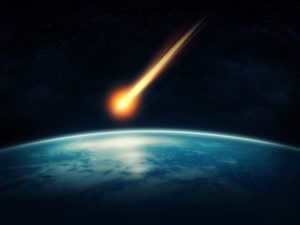
The atmosphere gives the impression of being weightless, but in reality, when a space object enters it at high speed, the frictional force is immense. It rapidly heats up and incinerates before it can pose any danger to living organisms.
As you can observe, it is not possible to survive on Earth without an atmosphere. However, any alteration in the composition of the gaseous envelope also poses a threat to life.
That is why scientists and community activists have been actively promoting the implementation of conservation laws and programs. It is now our responsibility to contribute towards our collective future.
The atmosphere, which is the gas envelope that surrounds our planet Earth, consists of five primary layers. These layers begin at the surface of the planet, starting from or even below sea level, and extend all the way to outer space in the following order:
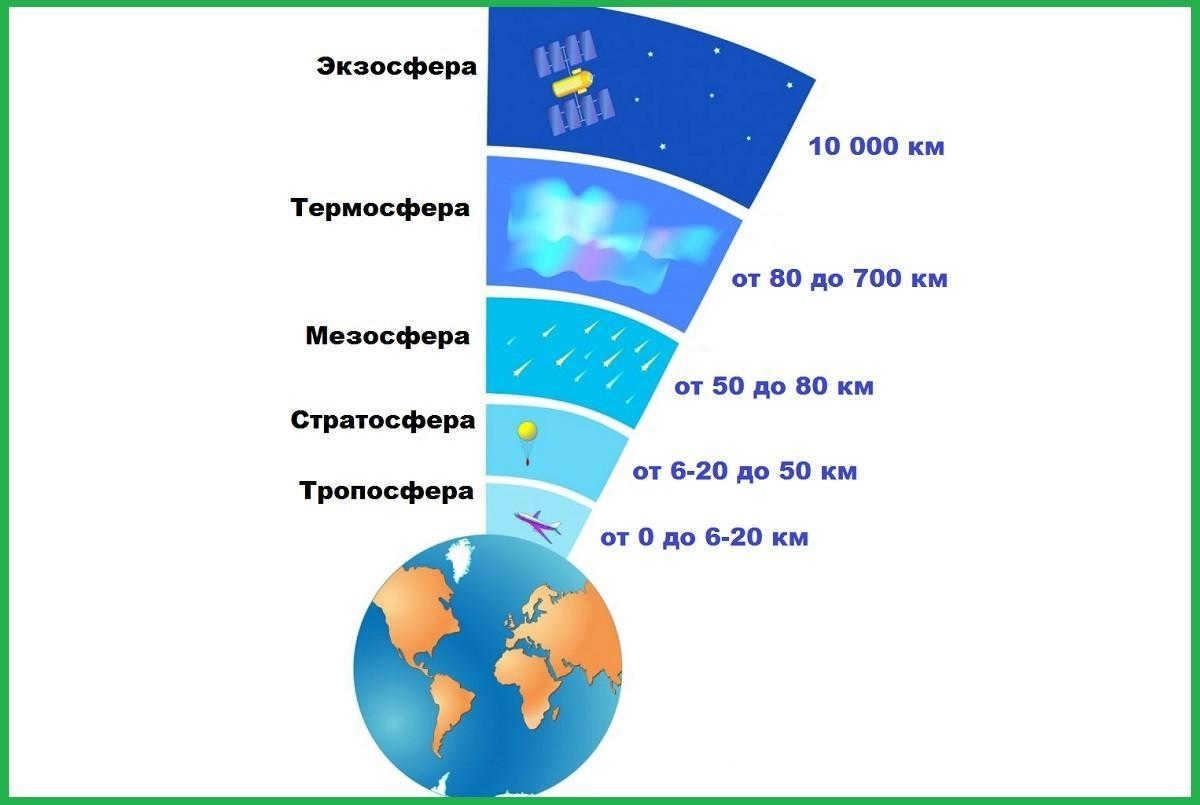
There are transitional zones known as “pauses” situated between each of the five primary layers of Earth’s atmosphere. These pauses are where alterations in temperature, composition, and air density occur. In total, Earth’s atmosphere consists of nine layers, including the pauses.
The troposphere: the birthplace of weather
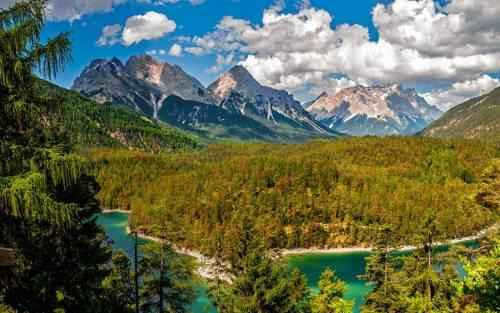
Out of all the atmospheric layers, the troposphere is the one that we are most familiar with (whether we are aware of it or not) because we reside at its lowest point – the Earth’s surface. It encompasses the surface of the planet and extends upwards for several kilometers. The term “troposphere” translates to “change of balloon”. This name is quite fitting as this layer is where our everyday weather phenomena occur.
Commencing at the surface of the planet, the troposphere extends to a height ranging from 6 to 20 kilometers. The lower third of this layer, which is closest to us, contains 50% of all atmospheric gases. It is the sole component of the entire atmosphere that undergoes respiration. Due to the fact that the air is heated from below by the Earth’s surface, which absorbs heat energy from the Sun, the temperature and pressure of the troposphere decrease as the altitude increases.
The tropopause, a thin layer, acts as a protective barrier separating the troposphere and the stratosphere.
The Stratosphere: A Place Where Ozone Thrives

The stratosphere is the subsequent layer of the atmosphere. It stretches from 6-20 km to 50 km above the Earth’s surface. This particular layer is where most commercial airplanes fly and balloons traverse.
In this region, the air does not move vertically but instead moves horizontally in rapid air currents. As one ascends, the temperature rises due to the presence of abundant natural ozone (O3), a byproduct of solar radiation and oxygen, which has the capacity to absorb the sun’s harmful ultraviolet rays (any temperature increase with altitude is referred to as an “inversion” in meteorology).
Due to the stratosphere’s temperature gradient, with warmer temperatures at the lower part and cooler temperatures at the upper part, the occurrence of convection (vertical movement of air masses) is infrequent in this region of the atmosphere. Remarkably, one can observe a storm occurring in the troposphere from the stratosphere as the stratospheric layer functions as a “cap” that prevents the penetration of storm clouds through convection.
Subsequently, the stratosphere is succeeded by another layer known as the stratopause.
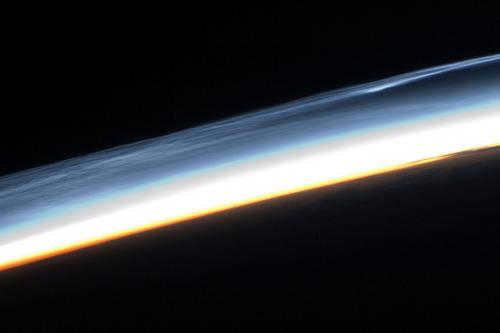
The mesosphere is located approximately 50-80 kilometers away from the Earth’s surface. Within the mesosphere lies the uppermost section, which is renowned as the coldest spot on our planet, where temperatures can plummet to as low as -143° C.
Thermosphere: the high-altitude atmosphere
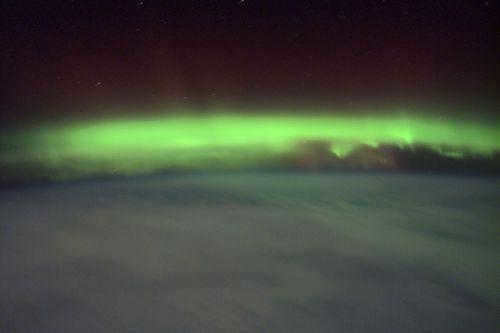
The thermosphere, which is situated between 80 and 700 km above the Earth’s surface, comes after the mesosphere and mesopause. It consists of less than 0.01% of the total air in the atmosphere. Despite reaching temperatures as high as +2000° C, the extreme rarity of air and the absence of gas molecules to transfer heat make these high temperatures feel extremely cold.
Exosphere: the line dividing the atmosphere and space
The exosphere is situated at an elevation of approximately 700-10000 km above the surface of the Earth, serving as the outermost boundary of the atmosphere that meets the realm of space. This region is occupied by weather satellites that revolve around our planet.
The ionosphere is not a distinct stratum, but rather a designation for the region of the atmosphere ranging from 60 to 1000 km in altitude. It encompasses the highest sections of the mesosphere, the entire thermosphere, and a portion of the exosphere. The ionosphere derives its name from the fact that within this atmospheric region, solar radiation becomes ionized as it traverses the Earth’s magnetic fields to the north and south. This occurrence is observable from the Earth’s surface as the aurora borealis.

Feel free to leave any comments or questions about the paragraph on the discussion page.
Atmosphere [ edit edit code ]
Concept and Structure of the Atmosphere [ edit correct code ]
The Earth’s atmosphere is composed of gases and forms a protective layer around the planet due to its gravitational force. It rotates along with the Earth as a cohesive unit.
The atmosphere consists of several layers, including the troposphere (up to 18 km), the stratosphere (up to 50 km), the mesosphere (up to 80 km), and the thermosphere, which gradually transitions into outer space.
Elements that make up the composition of air [ edit correct code ]
The composition of air consists of nitrogen, oxygen, and noble gases, primarily argon. These components remain constant in the troposphere.
| by volume | by mass | |
| Nitrogen ( N 2 ) >> | 78.08 | 75.51 |
| Oxygen ( O 2 ) >> | 20.95 | 23.15 |
| Argon ( Ar ) >> | 0.93 | 1.28 |
| Helium ( He ) >> | 0.00182 | 0.00125 |
| Neon ( Ne ) >> | 0.00053 | 0.00007 |
| Krypton ( Kr ) >> | 0.00012 | 0.00029 |
Analysis of atmospheric phenomena [ edit correct code ]
- Analyze phenomena such as the greenhouse effect, ozone depletion, cyclones, wind, typhoons, and tornadoes. What dangers do they pose, and what problems do they present for people?
The Earth’s atmosphere possesses the characteristic of allowing solar radiation to penetrate while impeding the escape of thermal radiation from the planet’s surface. This leads to a buildup of heat. The accumulation of gases and other emissions in the atmosphere intensifies this process, resulting in the greenhouse effect. related to the greenhouse effect.
This global issue has been present for a considerable amount of time. However, with the advancements in technology that contribute to higher emissions in the atmosphere, the increasing number of vehicles, and the overall degradation of the environment, it is becoming increasingly relevant. According to statistics, the average global temperature has risen by 0.74° in just the past century. On the surface, this may not seem like a significant change. Nevertheless, even this slight increase has already resulted in irreversible alterations to the climate.
The primary greenhouse gases include:
- Carbon dioxide. It has the longest lifespan in the atmosphere, leading to its continuous accumulation.
- Methane. Due to various properties, it is more active. According to Wikipedia, its atmospheric levels have increased over 150 times since 1750.
- Nitrous oxide.
- Perfluorocarbons.
- Sulfur hexafluoride.
- Water vapor contributes to the greenhouse effect in the atmosphere, and it is the main cause of the rise in temperature and humidity.
- Nitrogen oxides and freons are also greenhouse gases, and their concentration increases each year due to human activity, exacerbating the negative impact on the environment. [1]
- The ozone hole refers to the stratospheric zone with reduced ozone concentration, typically experiencing a 30% decrease on average. These gaps allow more harmful ultraviolet light to penetrate, affecting all living organisms.
The thinning of the ozone layer started in the 1970s. This occurred because ozone-depleting substances were entering the stratosphere. These substances primarily include chlorine and bromine, along with other compounds that result from deforestation, chemical emissions from factories, and rocket launches. Byproducts of human activity are released into the atmosphere and break down in the stratosphere due to exposure to ultraviolet light. The resulting bromine and chlorine then destroy ozone molecules. Even one molecule of chlorine can remain in the upper layers for over a hundred years and destroy at least a hundred thousand ozone molecules during that time.
The thinning of the ozone layer is linked to the emergence of numerous hazardous illnesses. These include cancerous processes and ocular disorders, particularly cataracts, which can result in total blindness. Furthermore, there is a weakening of the body’s immune system, leading to the development of diseases affecting all bodily systems.
Not only humans suffer from these consequences, but flora and fauna as well. This includes various species such as shrimps, crabs, algae, and plankton. All of them are integral parts of the biosphere, and changes in the population of one species can cause ripple effects on others.
A cyclone is an enormous atmospheric vortex with low air pressure. Within it, air masses always circulate counterclockwise in the northern hemisphere and clockwise in the southern hemisphere.
A cyclone is a phenomenon that can occur on various planets, including Earth. It is caused by the rotation of the celestial body and is known for its immense power, producing strong winds, precipitation, thunderstorms, and other weather phenomena.
Nature also presents us with the opposite of a cyclone, known as an anticyclone. As the name suggests, this phenomenon involves the movement of air masses in the opposite direction, counterclockwise in the southern hemisphere and clockwise in the northern hemisphere.
Anticyclones have the ability to stabilize weather conditions. They bring calm and tranquil weather to the areas they pass through, resulting in hot summers and frosty winters. [3]
When solar radiation reaches the surface of the planet, it heats up both the land and the ocean. However, the temperature increase is not uniform due to the varying distances from the Sun. The equatorial regions, being closer to the star, receive more energy compared to the polar regions. Additionally, the land heats up more rapidly than the ocean, but the heat is retained for a longer period of time in the aquatic environment.
Consequently, the air masses heated by the planetary surface are not uniformly warm in different areas. The warmer air streams rise to higher atmospheric layers, creating a void that is then filled by colder streams from less heated regions.
This collision between warm and cold air masses is the main cause of winds of different intensities. This process occurs globally, and it keeps the Earth’s atmosphere in constant motion: air currents collide, bend, twist, and form various weather phenomena such as clouds, vortices, hurricanes, and tornadoes.
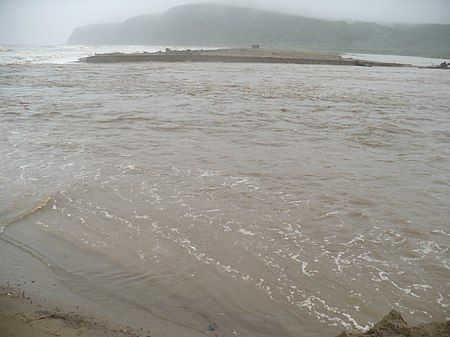
A tropical cyclone is a type of storm that occurs over the ocean surface and is characterized by a significant decrease in atmospheric pressure over the water’s surface.
A tropical cyclone is a massive circulating airflow around a central point (a large vortex of air). The wind speed within this funnel can reach 25 m/s, and the air is so dense that it behaves like a solid object. In simpler terms, a tropical cyclone is an extremely powerful wind.
Tropical cyclones develop in regions with hot climates, typically over seas or oceans. They form as a result of the evaporation of large amounts of moisture and the upward movement of air masses into the colder layers of the atmosphere. This process requires ample water and a hot climate capable of evaporating sufficient moisture.
When a powerful typhoon makes landfall, it causes immense destruction. The most powerful typhoons have the potential to claim the lives of thousands of individuals (fortunately, they are a rare occurrence). The typhoon with the highest recorded damage is Typhoon Bhola, which developed on November 7, 1970, and struck East Pakistan on November 12 (and dissipated a day later, on November 13). The calamity resulted in the loss of between 300,000 and 500,000 lives (up to half a million people!). This typhoon is regarded as one of the most deadly natural disasters in recent history. [6]
A tornado is a type of atmospheric vortex that forms within thunderstorm and cumulus clouds. These vortices are characterized by rapidly descending wind currents that create a large column extending from the cloud base to the ground. The diameter of the column can reach up to 400 meters at its base, and terrestrial tornadoes can sometimes be as wide as three kilometers. In contrast, water-based tornadoes are typically no wider than 40 meters. The constant movement of air masses within a tornado creates a vortex that pulls in any objects in its path. The internal flows of the tornado are drawn towards the surface, while the external flows rise upwards. As a result, the air inside the tornado becomes highly rarified.
When objects are caught in a tornado, they may explode due to the simultaneous pressure differentials. Enclosed buildings are particularly vulnerable to this phenomenon. No one is safe from the destructive power of a tornado. [7]
Clouds, fog, smog formation [ edit edit code ]
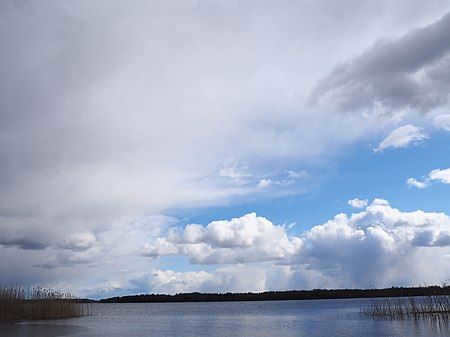
- Describe the process of cloud, fog, and smog formation.
An opaque mass of water droplets or ice crystals suspended in the atmosphere is what we call a cloud. Clouds are formed as a result of sunlight heating the Earth’s surface and causing water to vaporize. When moist and warm air rises from the Earth’s surface to higher altitudes, the water vapor condenses into tiny particles such as dust or salt particles. These particles then form liquid droplets or ice crystals, depending on the temperature. Eventually, the mass of the cloud becomes too heavy to be carried by upward air currents, and it falls as precipitation. [8]
One can interpret that fog is essentially a cloud that forms near the ground and consists of small water droplets. The process of fog formation is similar to that of cloud formation. When the relative humidity reaches the saturation point, known as the dew point, condensation occurs around airborne solid particles and small water droplets are created in the air. These solid particles that play a role in the process are referred to as condensation nuclei.
For instance, in sea fog, salt particles act as the condensation nuclei.
It is important to note that the size of fog droplets is greatly influenced by the purity of the air, or more specifically, the level of air pollution.
The relative humidity of the air can increase and reach the dew point due to factors such as:
- the cooling of moist air through adiabatic expansion;
- Direct air cooling is possible.
Fog can appear and vanish rapidly – unexpectedly. [9]
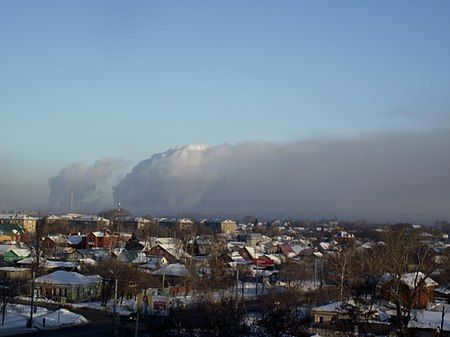
Smog is a phenomenon that occurs due to air pollution. It is commonly observed in densely populated areas, where the concentration of harmful substances exceeds the permissible limit and their dispersion is hindered by specific meteorological conditions.
Smog often occurs when warm air is above cold air, preventing the harmful substances from being dispersed. This is most commonly observed in windless weather or with minimal wind. Factors such as intense solar radiation and unfavorable location of a settlement, such as in a valley or basin, can contribute to the formation of smog.
Human activity is often the main cause of smog, although natural phenomena can also contribute to its formation.
Sources of pollutants:
- Coal-fired thermal power plants
- Homes using wood or coal for heating
- Vehicles with internal combustion engines
- industrial plants,
- agriculture,
- garbage processing plants. [10]
Instruments for measuring air [edit correct code]
To measure atmospheric pressure, a device called a barometer is used. A mercury barometer is quite accurate but not very convenient to use. An alternative is an aneroid barometer, which is less accurate but more convenient.
The most commonly used instruments for measuring air humidity are the hygrometer and the psychrometer.
The principle of operation of a hygrometer is based on measuring the concentration of water molecules in the surrounding air. Different types of hygrometers are available for purchase, including weight, hair, condenser, and psychrometric hygrometers.
One way to measure the humidity of the air is by using a psychrometer. A psychrometer is a device that looks like a thermometer with two scales. The first scale always remains dry, while the second scale is wrapped in a damp cloth. As moisture evaporates from the cloth, the readings on the second scale become lower than those on the dry scale. The greater the evaporation, the less moisture there is in the surrounding air. By comparing the readings on the dry and wet scales, you can determine the level of humidity in the air. To calculate the humidity, you will need to consult a special table. [11]
Comparing the Northern Lights and Rainbows [edit edit code]
- Analyze and explain the physical nature of two atmospheric optical phenomena: the Northern Lights and Rainbows.
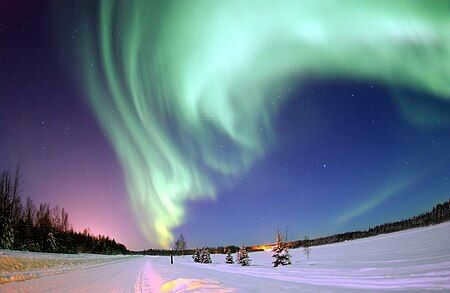

Polar lights are a natural phenomenon that occurs in specific regions of the Earth’s upper atmosphere. These mesmerizing lights are caused by charged particles from the solar wind entering the ionosphere near the Earth’s poles. These particles make their way through the polar caspas, which are unique areas in the magnetospheric layer resembling funnels.
When the energetic particles from the solar wind collide with the molecules and atoms in the upper atmosphere, they cause these particles to become highly energized. This excitement leads to a beautiful luminescent glow in the atmosphere, which is visible to the naked eye and commonly known as the northern lights. The northern lights are a breathtaking sight that captivates anyone lucky enough to witness them. [12]
The phenomenon of the rainbow occurs when sunlight is refracted in water droplets found in rain or fog in the atmosphere. These droplets refract light of different colors at varying degrees, resulting in the separation of white light into a spectrum. This dispersion is caused by the fact that the refractive index of water is smaller for longer-wave (red) light compared to shorter-wave (violet) light. As a result, red light is deflected less when refracted, while violet light is deflected more. This creates the distinct colors of the rainbow, with red appearing at an angle of 137°30' and violet at an angle of 139°20'. When observed, it appears as if multicolored glow is emanating from concentric circles (arcs), with the bright light source always positioned behind the observer. [13]
Therefore, it can be concluded that the rainbow is a purely optical phenomenon, while the northern lights are electromagnetic in nature.
Additional questions about the paragraph [edit edit code]
The contributions of Evangelista Torricelli to science [edit correct code].
- Who is the scientist, a student of Galileo, who first demonstrated the existence of atmospheric pressure and created the initial barometer?
Evangelista Torricelli, a student of Galileo, is forever remembered in the field of physics as the individual who initially demonstrated the existence of atmospheric pressure and created the first barometer.
Animal Behavior and Weather Forecasting
- Provide examples of how animals can predict the weather based on your biology course and personal observations.
Animals and plants are believed to possess the ability to predict the weather. Frogs, in particular, are highly accurate in this regard due to their thin and sensitive skin. During hot weather, they seek refuge in water, while during rain, they venture out onto the ground. They react to sudden downpours by croaking loudly, and to cold temperatures and frost by emitting faint melodies.
If you don’t have a body of water nearby, observe the behavior of birds. If they gather in flocks and make noise while perched on a tree, it’s a sign of an upcoming downpour. On the other hand, if they splash around in puddles, it indicates hot weather.
Here’s how cats predict the weather:
- If they curl up into a tight ball, expect frosty conditions.
- When a cat sneezes, it indicates heavy rains.
- If a cat sharpens its claws on furniture, it suggests changes in the street.
- When a cat clutches its paws while sleeping, it means it will be cold.
- If a cat is scraping the floor, it is a sign of bad weather conditions.
Here’s how dogs predict the weather:
- If a dog is lying in the grass, it means it will rain and be windy. If it’s lying in the snow, it predicts a blizzard.
- If a dog is not eating well and wants to sleep, it indicates strong changes in the weather.
- If a dog is splashing in a puddle, it suggests a downpour.
- When a dog curls up in a roll, it means a snowstorm and cold weather are coming.
- If dogs are chasing each other and lying in the snow, it indicates that it will soon get warmer.
Weather signs from animals can also be interpreted by livestock:
- If a horse wheezes and falls to the ground, it indicates bad weather is coming.
- When sheep and rams collide their foreheads, it indicates the arrival of a strong wind.
- By observing the behavior of pigs, one can predict the weather. If there is a storm approaching, the animals gather straw, bury themselves in it, and huddle closely together. Many other animals exhibit similar behavior when cold weather is imminent.
Other animals, including insects and fish, which are also highly sensitive, can also forecast weather conditions:
- If you spot a large group of spiders, it signifies stable weather without any impending troubles. If there are no insects in sight, be prepared for a thunderstorm.
- If a spider remains motionless in the center of its web, it suggests dampness.
- If flies are buzzing around in the morning, it indicates a hot day ahead. If there are no flies at all, expect cold weather.
- If you come across a large number of crustaceans in the spring, it suggests a dry summer.
- A group of dragonflies indicates that there will be precipitation. The chirping of grasshoppers indicates that the day will not be cloudy. The same conditions outside the window signal the presence of bright fireflies. [14]
The functioning of the barometer-aneroid, hygrometer, psychrometer [ edit edit code ].
The aneroid barometer is based on a corrugated metal box. The box is devoid of air, as it is removed during the manufacturing process of the barometer. To prevent the box from collapsing under atmospheric pressure, it is supported by a flexible metal plate. One end of the plate is connected to the base of the barometer, while the other end is linked to the barometer’s pointer through a special mechanism.
If there is a change in atmospheric pressure, the force that squeezes the metal box will also change accordingly. Consequently, even a slight variation in the thickness of the box will result in a noticeable displacement of the arrow at the scale, as it passes through the plate and mechanism. [15]
An hygrometer is a device used to measure the humidity of the air in a room. Insufficient moisture in the air can allow various viruses to enter the body, which can greatly weaken the immune system. The hygrometer helps to prevent discomfort and protect the mucous membranes and skin from drying out.
This device operates on the principle of utilizing the physical properties of its constituent materials. These materials undergo changes in their properties based on the moisture level in the air, such as weight, density, length, and others.
- hair,
- film,
- weighing,
- condensation,
- psychrometric,
- electronic.
The hair hygrometer is composed of a synthetic hair that has been stripped of fat, an arrow, a spring, and a scale. As the amount of moisture in the air changes, the tension force exerted on the hair also changes, causing the spring to react and move the arrow to a different position on the scale. The hair hygrometer is capable of determining humidity levels within the range of 30 to 80%.
The sensing mechanism of a film hygrometer consists of a thin film that expands or contracts based on the humidity level. This motion is then translated into a change in the position of a counterweight, which in turn adjusts the angle of the arrow on the scale. Similar to the hair hygrometer, the film hygrometer is designed to measure humidity levels between 30 and 80%.
The weighted mechanical and condensation hygrometer is known for its high precision in measuring room humidity levels, as both devices are designed to measure absolute air humidity. These instruments are typically used in laboratory settings and are not intended for measuring the humidity of home air.
A psychrometer operates by utilizing the interaction between “dry” and “wet” thermometers. This instrument consists of two thermometers filled with colored liquids (red and blue). One of the thermometers is wrapped with a cotton cloth, the end of which is submerged in a solution reservoir. The cloth becomes wet and the moisture starts to evaporate, causing the “wet” thermometer to cool down. The lower the humidity in the room, the lower the reading on the thermometer will be.
To determine the percentage of air humidity using a psychrometer, one must refer to the device’s temperature table and locate the corresponding air temperature value based on the thermometer reading. By comparing the values at the intersection, the difference can be calculated. [16]
We have a fascination with the enigmas of outer space and often overlook the fact that there are many intriguing phenomena much closer to home. Take, for instance, the Earth’s atmosphere, the gaseous mantle that envelops our planet. The Earth’s atmosphere is vast, spanning thousands of kilometers, and it is a complex and ever-changing entity, highly responsive to various factors. In this article, we will delve into the composition of the atmosphere and explore its origins and evolution. We will outline the different layers that comprise the atmosphere, highlighting their unique properties and significance for sustaining life on Earth. Additionally, we will compare and contrast the Earth’s atmosphere with the gaseous envelopes found on other planets.
Characteristics of the atmosphere


The atmosphere is a protective shield of gas that safeguards all forms of life from extraterrestrial dangers. One crucial component of this shield is the ozone layer, which shields us from the sun’s harmful ultraviolet radiation. Additionally, this gaseous shell burns up a significant number of incoming meteors. Furthermore, it is responsible for maintaining the Earth’s surface temperature, ensuring a comfortable climate. The clouds in our atmosphere reflect the sun’s rays, creating a greenhouse effect that prevents a temperature drop of at least 20 degrees. Moreover, the atmospheric water cycle not only provides favorable climatic conditions but also contributes to a rich abundance of mineral substances. There is no other place in the entire system comparable to our atmosphere.
The complete gaseous envelope stretches across thousands of kilometers. However, only those gases that move with the planet around its axis at the same velocity are considered part of the atmosphere. It reaches a height of approximately 1,000 kilometers and seamlessly blends with space, with the exosphere marking the boundary.
Developmental Background
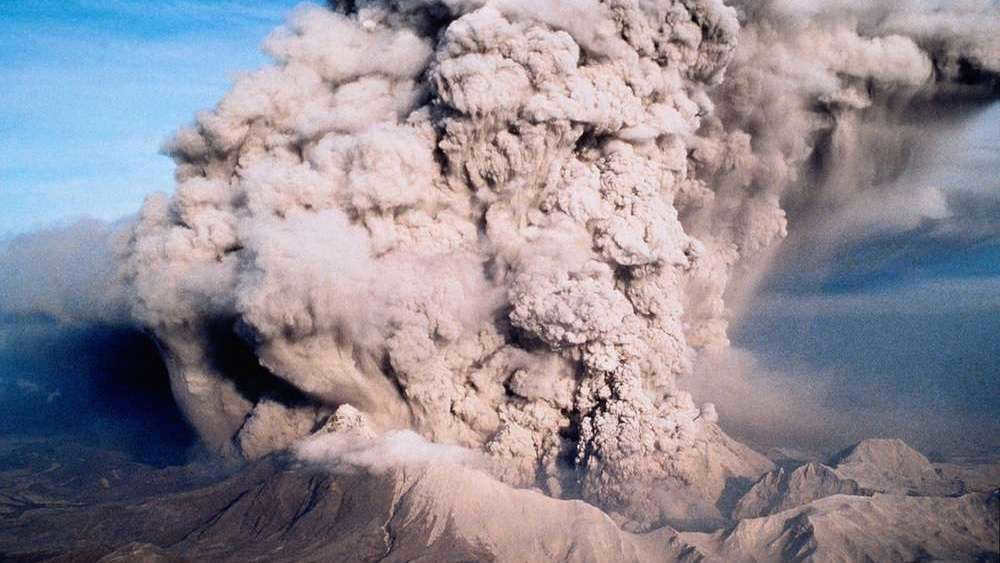

The composition of our planet’s atmosphere is not as simple as it may seem at first glance. While air appears homogeneous, it is actually a complex mixture of numerous gases. If we consider only the gases that make up at least one-thousandth of the total volume, we can identify twelve distinct gases. However, if we take into account all of the gases present, we discover that our atmosphere encompasses all of the elements found on the periodic table. The remarkable diversity of gases within our atmosphere is a result of the presence of life on our planet.
In its early stages, the Earth’s atmosphere was significantly different from what it is today. At that time, the gas layer surrounding our planet was extremely thin, allowing meteorites to easily pass through it. The surface of the Earth was dotted with circular lakes, which were formed by the impact of falling meteorites.
However, the emergence of oxygen was an extremely significant event that had a profound impact. The process by which it came into existence can be credited to the mantle releasing gaseous compounds that had built up beneath the Earth’s crust. Another source of oxygen was through the creation of water vapor by volcanoes, which then broke down into hydrogen and oxygen through the influence of ultraviolet radiation. Unfortunately, this oxygen was not able to exist for a long period of time as it quickly reacted with various elements such as iron and sulfur. These reactions were further accelerated by the sun. This situation would have persisted if life had not appeared on our planet.
Following the emergence of existence.

The planet’s atmosphere is composed of various elements and gases. Over time, living organisms have played a significant role in shaping the composition of the atmosphere. Oxygen, for example, has gradually increased in concentration, thanks to the production of large amounts of it by living things. It took billions of years for the oxygen levels to rise from 0% to 21% of the atmosphere.
Simultaneously, organisms have also played a role in utilizing atmospheric carbon. They have used carbon to build their skeletons and other structures. This process has led to the accumulation of organic materials on Earth’s crust, resulting in a decrease in the amount of carbon dioxide present in the atmosphere.
Thanks to the presence of oxygen, our planet has developed a beautiful blue haze, giving it the appearance of a small blue dot when viewed from a distance. Additionally, oxygen is the primary reason why we perceive the sky as blue. The abundance of oxygen has also led to the formation of the ozone layer, which continues to protect us from harmful solar radiation. This availability of oxygen has played a crucial role in the evolution of various organisms, allowing not only bacteria and algae to thrive, but also giving rise to highly advanced creatures.
Furthermore, our atmosphere also contains noble gases, with argon being the most abundantly present among them, accounting for approximately 0.9-1% of the atmosphere. Argon is produced through nuclear processes deep within the Earth’s core and is released into the atmosphere during volcanic eruptions and through cracks in the Earth’s crust. These noble gases eventually rise to the upper layers of the atmosphere before dispersing into the vastness of space.
The composition of the atmosphere
An earlier mention was made of a unique layer known as the exosphere, but there are other significant components that deserve attention. Let’s examine the primary elements.
The Troposphere

The first and most dense layer. Its thickness varies depending on the location, ranging from approximately 7 km at the poles to about 20 km at the equator. These measurements fluctuate with the seasons, as warm air rises. We all reside in the troposphere, which gets its name from the Greek word “change”. This name accurately reflects its nature, as the troposphere is constantly changing. It is within this layer that winds, cyclones, anticyclones form, clouds develop, and all the processes related to weather and climate occur.
The troposphere comprises approximately 80% of the atmosphere’s mass. Its weight is attributed to the high concentration of water in this layer. As you ascend from the surface, the temperature gradually decreases, with a decrease of about 0.5-0.7 degrees per hundred meters of elevation. This temperature pattern is unique to the troposphere; other layers of the atmosphere exhibit different temperature trends, with higher altitudes corresponding to higher temperatures. Additionally, wind speed is influenced by altitude, with the wind accelerating by 2-3 kilometers per second for every kilometer climbed.
For this reason, paragliders and hang gliders often seek out mountainous regions, where they can reliably take advantage of the air currents.
There exists an atmospheric layer above the troposphere, and subsequently there is the lithosphere. This is the boundary region, which is accountable for the transmission of heat and radiation from outer space. Within it, the exchange of water occurs, constituting the well-known water cycle in nature that is taught in middle school. The water that ascends from the surface returns within a span of 8-12 days, and the troposphere itself functions as a sort of water filtration system.
As the elevation increases, the atmospheric pressure also undergoes changes. The standard pressure at the surface is one atmosphere or 1012 mbar, while at the uppermost part of the troposphere it is reduced to 200 mbar, and at a height of 45 km above the surface it diminishes to just one mbar. This offers another explanation as to why the troposphere constitutes 80% of the overall weight of the atmosphere.
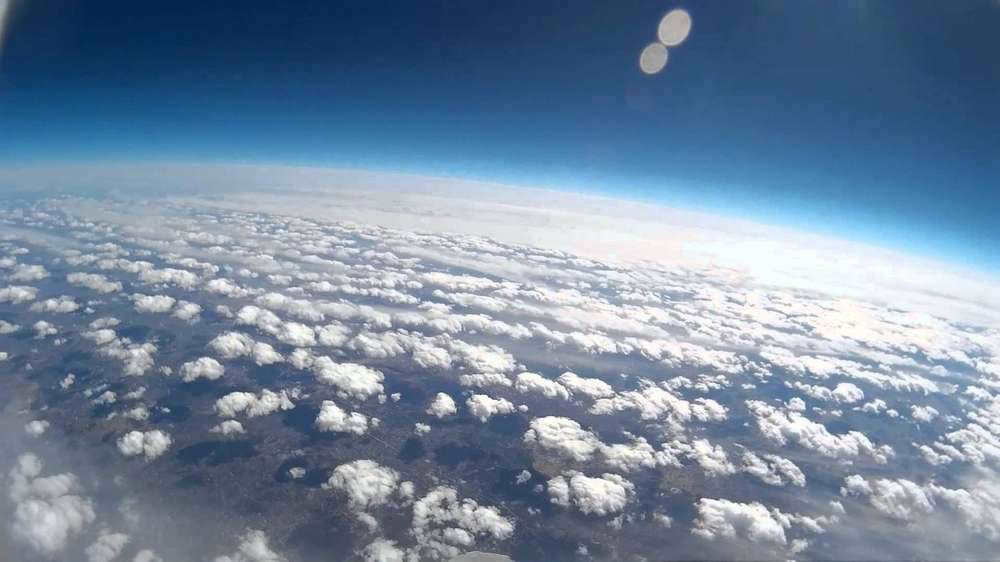
The stratosphere, with its height reaching 50 km at the equator and 8 km at the poles, is known as the “layer” in Greek. This atmospheric layer is characterized by its rarity, with the pressure being ten times lower than at the surface at its lower boundary and almost one hundred times lower at its upper boundary. Furthermore, the stratosphere is virtually devoid of water vapor. As one ascends through the stratosphere, the temperature gradually increases from minus 56 to minus 1 degrees Celsius.
The lower section of the atmosphere is designated for supersonic and conventional passenger planes. In this region, they can minimize fuel consumption due to reduced air resistance and benefit from protection against air currents. However, these aircraft are limited in their ability to ascend further, as jet engines require a sufficient air supply. Moving into the stratosphere at altitudes ranging from 18-30 km, one can find high-speed military aircraft and passenger planes like the “Concorde.” Additionally, this region is utilized for meteorological research, with the deployment of airborne probes carried by weather balloons.
Microbes inhabit this layer, extending all the way up to the ozone layer. This layer is commonly known as air plankton. However, there has been an unusual incident: an airplane engine at an altitude of 11.5 km had a vulture stuck in it. It is also worth noting that during migration, ducks have been observed flying above Mount Everest. Nevertheless, the largest organism to have reached this height is a human, to be more precise, a specific individual by the name of Alan Eustace, who was the vice president of Google at the time. At the age of 57, he ascended to a height of 41 km in a balloon and then made a parachute jump. This feat set a world record. Eustace, the record holder, was clad solely in a protective suit and did not utilize an airtight capsule or any other form of protective gear.

The ozone layer, which protects us from solar radiation, is situated between the stratosphere and the mesosphere. Life cannot exist above this layer due to the lethal radiation, making it a vital shield. Ozone is formed through a photochemical reaction between oxygen and ultraviolet radiation in the upper atmosphere. This reaction converts O2 into O3, creating the protective layer that shields us from the harmful effects of the Sun’s radiation.
The region of the Earth’s atmosphere known as the mesosphere
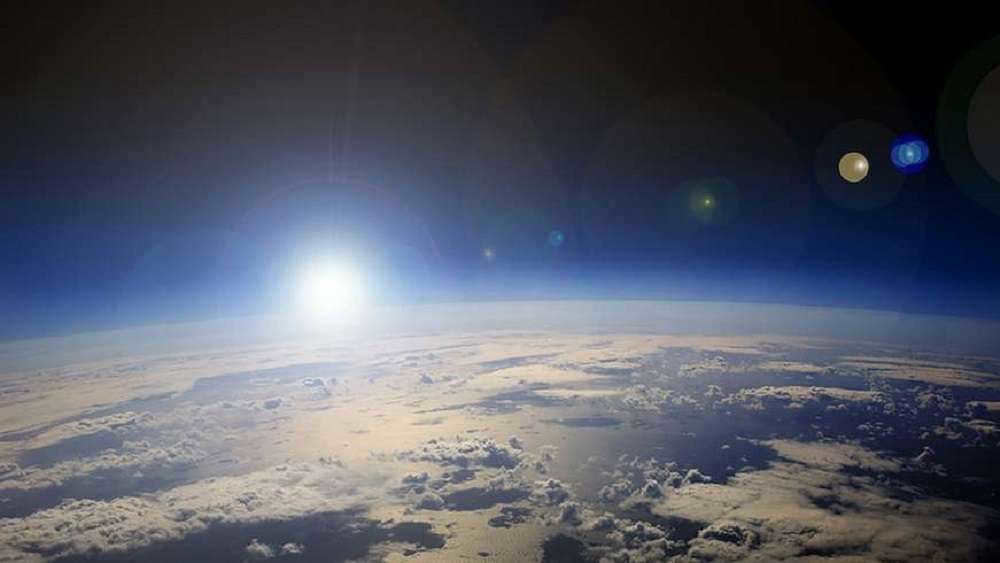
This location holds the record for being the most frigid spot on Earth, with temperatures in the upper atmospheric layer dropping to a bone-chilling minus 143 degrees Celsius. The mesosphere, which is the layer being discussed, remains relatively unexplored compared to other layers due to its challenging working conditions. Balloons are unable to ascend beyond a certain point as the air pressure becomes exceedingly low. Even jet airplanes are incapable of flying in this region as the principles of aerodynamics cease to apply. However, rocket-powered aircrafts like the X-15 rocketplane have the capability to traverse through this layer. The X-15 holds the title for being the fastest aircraft in the world, reaching speeds of up to 7200 kilometers per hour and achieving altitudes of 108 kilometers.
However, when it comes to scientific exploration, the X-15 does not offer much value as it is primarily used for conducting fast-paced research. Its flights at such high altitudes are short-lived, with the longest X-15 flight lasting just 15 minutes. Suborbital probes and satellites are ineffective in this environment due to the low pressure, which either hinders their progress or causes them to burn up completely. Interestingly, this is also the location where the majority of meteors disintegrate, and where the Perseids meteor shower dazzles observers every August. The term “ignorance” is the English translation of its name, which seems quite fitting for a place that remains largely unexplored.
Thermosphere
The thermosphere is one of the layers of Earth’s atmosphere. It is located above the mesosphere and below the exosphere. The thermosphere extends from about 80 kilometers (50 miles) to 600 kilometers (375 miles) above the surface of the Earth. It is named for its high temperatures, which can reach up to 2,500 degrees Celsius (4,500 degrees Fahrenheit) due to the absorption of high-energy solar radiation. The thermosphere is also home to the International Space Station and other satellites, as the thin air allows them to orbit the Earth without much resistance.
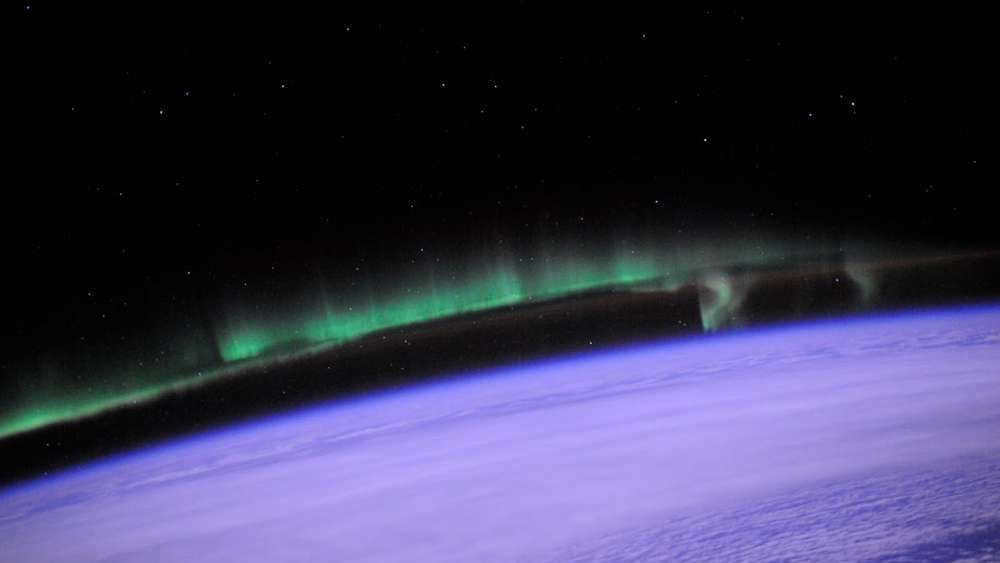
After leaving the mesosphere, you will find yourself in what is known as the Karman line. Once you cross this boundary, you enter the realm of near space. However, far space lies even further beyond. To delve deeper into this fascinating subject, be sure to check out the article on “Fascinating Discoveries in the Astronomy of Deep Space”.
The pocket line is located at an elevation of 100 kilometers above sea level. This serves as the lower boundary of the thermosphere, which is the longest-lasting layer. Its height extends to 800 kilometers, and the temperature rises to an astonishing 1800 degrees at an altitude of 400 kilometers, which is the absolute maximum. To put this into perspective, the temperature at which iron starts to melt is 1538 degrees. However, spacecraft are still able to surpass this temperature barrier due to the extremely low pressure in this region, which is a million times lower than that on the Earth’s surface. Although the particles here are incredibly hot, they are spread thinly enough to not cause any damage. Additionally, spacecraft are equipped with special emitters that reflect the incoming energy.
The outermost layer of the Earth’s atmosphere is known as the exosphere
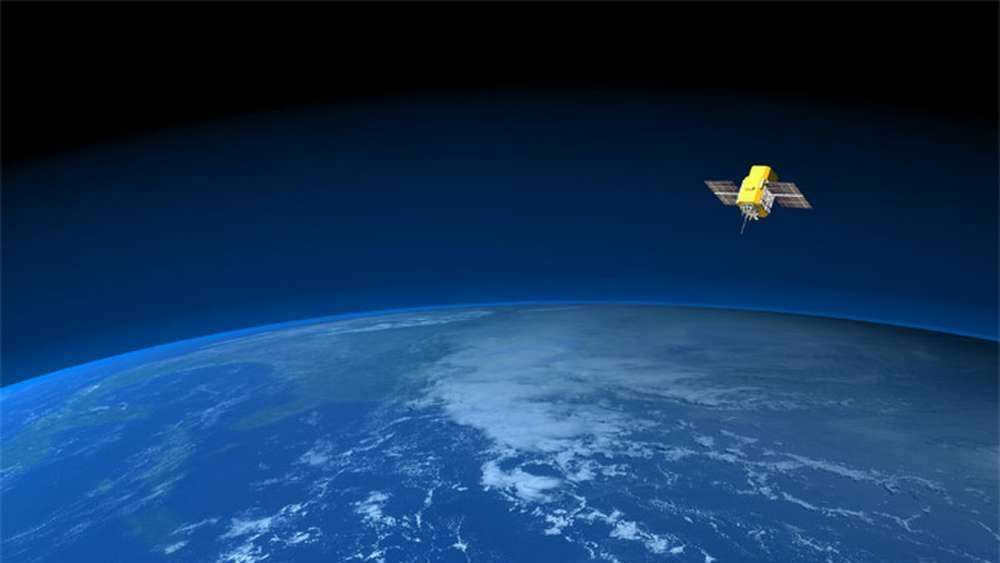
The outermost layer, which begins 700 kilometers above the planet’s surface, is known as the exosphere. The prefix “exo” in Greek means “outside”. It is a very thin layer, predominantly made up of hydrogen, which is a very light element. Additionally, there are nitrogen and oxygen atoms present in the exosphere, although they become highly ionized by the Sun’s radiation. The exosphere extends up to a hundred thousand kilometers from the Earth and its particle concentration is millions of times less dense than the air we are accustomed to. Under specific conditions, it can appear like a corona encircling our planet when observed from space.

Not only is the atmosphere of our planet essential for sustaining life, but it also serves as a valuable tool for studying the gaseous envelopes of other planets. Research has demonstrated that the color of an atmosphere can provide insights into the composition of a planet. For instance, Mars and certain exoplanets exhibit a red hue, indicating a high concentration of carbon dioxide gas. This suggests the presence of active geological processes and an abundance of volcanoes.
While the presence of water vapor does not necessarily imply the existence of surface oceans, it does signify the presence of oxygen. And if there is an ample supply of oxygen, it suggests the possibility of some form of life on the planet. As mentioned earlier, oxygen cannot accumulate from non-living sources.

